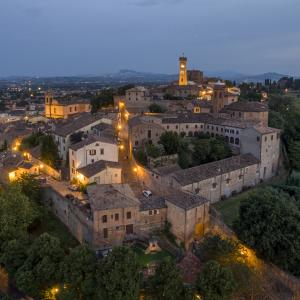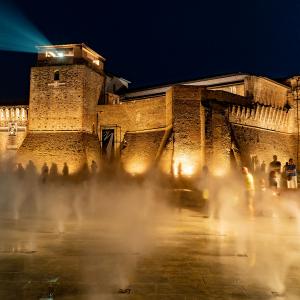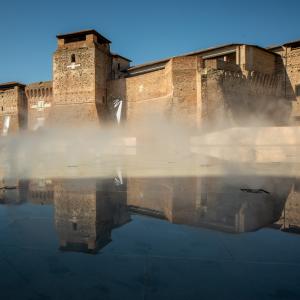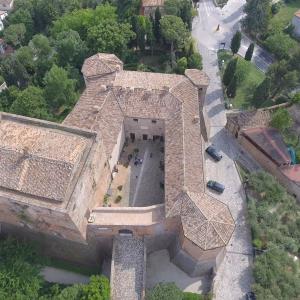Damned lovers: Paolo and Francesca
Everyone knows the tragedy of the two unfortunate lovers, Paolo and Francesca, but it is not certain where it actually took place.
In Romagna, several Malatesta fortresses have applied to be the place that hosted the well-known lovers, and over the centuries some more than others have grabbed the exclusive right. We like to tell you that many mysterious factors are in play here too, and legends have often taken over reality. And this is in spite of non-coinciding dates and non-existent documents.
We begin this study with a first hypothesis.
For some, the terrible event took place in the original fortress of Santarcangelo di Romagna. But Rimini certainly hosted them and it is known that today the Rocca (Fortress) of the unfortunate lovers is in Gradara.
Anyway, here's their story. Francesca from Ravenna was the daughter of Guido da Polenta the Minor, lord of Ravenna, "very beautiful and with a haughty soul, educated in courtesy and the rules of polite speech". Unfortunately, the city of Ravenna, like other municipalities in Romagna, was gripped by conflicts and political struggles, and Francesca "a flower in the midst of so much iron" as D'Annunzio described her, was an innocent victim. Practically speaking, she had to sacrifice herself to the laws and customs of the time according to which marriages sealed pacts and political-strategic alliances. So, it was decided that she would marry Giovanni Malatesta known as "Gianciotto", the son of the powerful lord of Rimini. And here was where the fatal deception was hatched for fear that the girl would refuse. Francesca was led to believe that she was going to marry the charming Paolo known as Il Bello (The handsome one), Gianciotto’s brother, who, having gone to Ravenna equipped with a special power of attorney, married her. Francesca accepted with joy and without any doubt, happily pronounced her "I do" without knowing that Paolo was marrying her "artificially" by proxy, that is in the name of and on behalf of his brother Gianciotto. Having reached the future Malatesta residence, however, she became aware of the deception. Paolo was not her husband, but Gianciotto. Despondency enveloped her and her desperation did not recede, on the contrary, it grew day after day. Soon the young woman was able to console herself in the arms of the one she had loved from the first moment, her brother-in-law Paolo, but the happy story turned into a tragedy because one day Gianciotto, having returned to the castle, perhaps warned by a faithful servant, or perhaps by his brother Malatestino dall'Occhio, surprised the two lovers and killed them by piercing them with a sword. And thus, their story entered history forever, first of all that of the Malatesta family, the da Polentas, the Seigneuries of the time, but also in the history of world literature which was so fascinated by it and created verse upon verse about it.
The first to do that was Dante Alighieri. The tragedy of Paolo and Francesca is known thanks to the “Sommo” (the Supreme poet, that is Dante) and the fifth canto of his Divine Comedy. The poet placed Paolo and Francesca in the second circle of Hell, that of the lustful, where an incessant storm beats the souls, so that the lovers are subjected to a wind similar to that of the passion that swept them away in life.
At this point the dilemma remains: the location of this tragedy.
The real setting could truly be Santarcangelo. At the moment, it is not possible for anyone to know for sure. However, this hypothesis is supported by some historians and experts and there are also those who claim to have seen, on moonless nights, the restless spirit of Francesca, dressed in white, strolling, sighing, among the alleys of the medieval hamlet, immobile guardians of her eternal sufferings. And in the Rocca, creaks and drafts have been and are interpreted as wails of pain for what happened...
People say that Concordia Malatesta, Francesca’s daughter, lived there and she asked her grandfather to build a convent of the Order of the “sepolte vive” (buried alive) in memory of her mother, and this precisely in Santarcangelo where she had been killed. Popular imagination adds that Concordia Malatesta, desperate due to the death of her mother, then retired to the Convent of the "Sepolte vive" founded by herself and located in what is now Piazza Monache, probably where the more recent convent of the Poor Clares is now located, next to the beautiful church dedicated to Saints Catherine and Barbara and where it is also possible to stay the night. In the square, there is a ceramic plaque, walled into the facade of a house, with the image of a sad girl who reminds the visitor of the ancient legend.
Since the story is not supported by any documents, Paolo and Francesca could certainly have been in any of the Malatesta Roccas at the time of the killing, even that of Rimini.
Today, however, there is one that has officially applied to host the event, the Rocca of Gradara. The splendid, fascinating town of Gradara already enchants the visitor from a distance as, when traveling along the motorway, it appears intact and elegant way up high, among the green countryside full of olive trees and vines, with the walls and the castle preserved from the wear and tear of time.
The Rocca and its fortified hamlet represent one of the best-preserved medieval structures in Italy and the two walls that protect the Fortress, the outermost of which extends for almost 800 meters, also make it one of the most majestic. ...
Legend has it that the tragedy of Paolo and Francesca took place here under the Malatesta dominion, made famous by Dante's moving and passionate verses: "He, trembling, kissed my mouth, the book was a Gallehault indeed as was whoever wrote it: that day, we did not read another page". The two were surprised by Gianciotto who pierced them with a sword. Dante places Paolo and Francesca in Hell among the lustful, condemned to divine damnation but with his verses he pushed them to eternal commemoration, elevating them to symbols of love.



